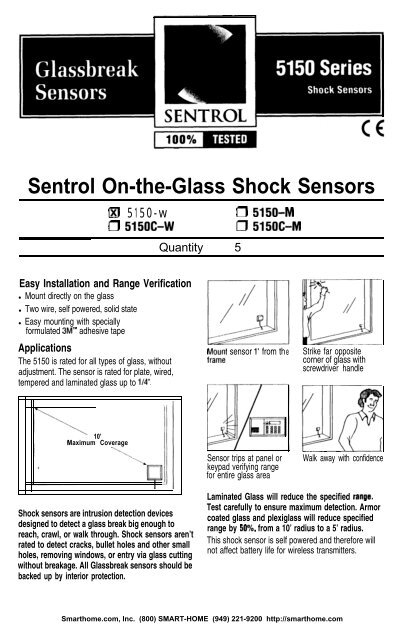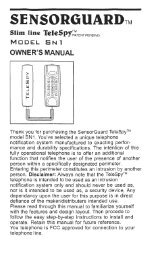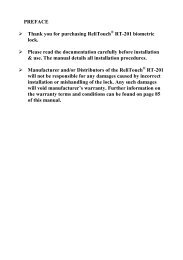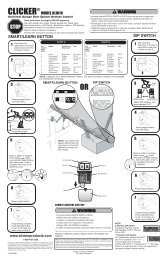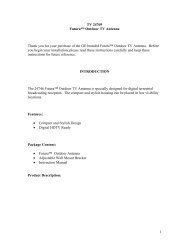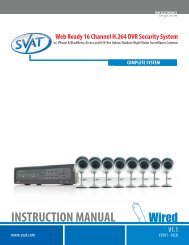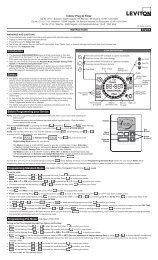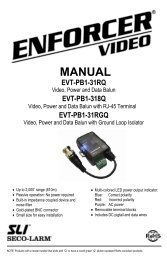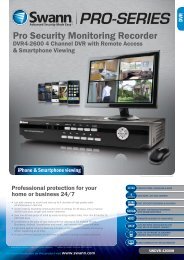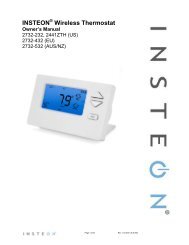Sentrol On-the-Glass Shock Sensors - Smarthome
Sentrol On-the-Glass Shock Sensors - Smarthome
Sentrol On-the-Glass Shock Sensors - Smarthome
Create successful ePaper yourself
Turn your PDF publications into a flip-book with our unique Google optimized e-Paper software.
<strong>Sentrol</strong> <strong>On</strong>-<strong>the</strong>-<strong>Glass</strong> <strong>Shock</strong> <strong>Sensors</strong><br />
liTi 5150-w 0 5150-M<br />
cl 515oc-w 0 515OC-M<br />
Quantity 5<br />
Easy Installation and Range Verification<br />
• Mount directly on <strong>the</strong> glass<br />
• Two wire, self powered, solid state<br />
• Easy mounting with specially<br />
formulated 3M’” adhesive tape<br />
Applications<br />
The 5150 is rated for all types of glass, without<br />
adjustment. The sensor is rated for plate, wired,<br />
tempered and laminated glass up to l/4”.<br />
ri;;t sensor 1” from <strong>the</strong><br />
Strike far opposite<br />
corner of glass with<br />
screwdriver handle<br />
.<br />
10’<br />
Maximum Coverage<br />
‘\<br />
\<br />
Sensor trips at panel or<br />
keypad verifying range<br />
for entire glass area<br />
Walk away with confidence<br />
<strong>Shock</strong> sensors are intrusion detection devices<br />
designed to detect a glass break big enough to<br />
reach, crawl, or walk through. <strong>Shock</strong> sensors aren’t<br />
rated to detect cracks, bullet holes and o<strong>the</strong>r small<br />
holes, removing windows, or entry via glass cutting<br />
without breakage. All <strong>Glass</strong>break sensors should be<br />
backed up by interior protection.<br />
Laminated <strong>Glass</strong> will reduce <strong>the</strong> specified ranoe.<br />
Test carefully to ensure maximum detection. Armor<br />
coated glass and plexiglass will reduce specified<br />
range by 50%, from a 10’ radius to a 5’ radius.<br />
This shock sensor is self powered and <strong>the</strong>refore will<br />
not affect battery life for wireless transmitters.
Step 1- Mounting<br />
To maximize range, mount <strong>the</strong> 5150 Series shock<br />
sensor approximately 1” out from any side of <strong>the</strong><br />
frame.<br />
<strong>Sensors</strong> mount with industrial grade acrylic tape<br />
specifically formulated to resist <strong>the</strong> effects of<br />
sunlight and extreme temperature changes after<br />
application.<br />
For best adhesion:<br />
<strong>Glass</strong> must be clean and dry. With a clean<br />
cloth, apply a 50/50 solution of isopropyl<br />
alcohol and water to remove residue.<br />
The ideal mounting temperature is 70” to<br />
100°F (21 O to 38°C). Application at glass<br />
temperatures below 50°F (1OOC) is not<br />
recommended because <strong>the</strong> adhesive may<br />
become too firm to adhere readily. <strong>On</strong>ce <strong>the</strong><br />
tape is applied, however, low temperatures<br />
do not effect bonding.<br />
Bond strength depends on how much<br />
surface contact develops. Press <strong>the</strong> sensor<br />
firmly to <strong>the</strong> glass. Firm application pressure<br />
develops better adhesion and thus improves<br />
<strong>the</strong> bond.<br />
Step 2- Wiring<br />
The 5150 is a two wire device. It draws no power<br />
from <strong>the</strong> loop. The sensor generates its own power<br />
by converting <strong>the</strong> shock energy of <strong>the</strong> break into<br />
electricity using a piezo transducer.<br />
All 5150 Series shock sensors are non-polarity<br />
sensitive. The alarm output operates without respect<br />
to polarity and wires directly into <strong>the</strong> closed loop.<br />
When wiring multiple sensors in series, be aware<br />
that resistance is additive. The value of <strong>the</strong> end-ofline<br />
resistor may have to be adjusted when a large<br />
quantity of sensors are in series. <strong>Sentrol</strong><br />
recommends a maximum of 10 sensors in series.<br />
The 5150 does not require a processor. Do not wire<br />
<strong>the</strong> sensor into fast response loops-false alarms<br />
will result.<br />
Step 3- Testing<br />
The 5150 sensor is tested by rapping <strong>the</strong> glass with<br />
<strong>the</strong> handle of a large screwdriver. Test at likely<br />
points of attack - near door and window latches<br />
and <strong>the</strong> lower points where it can be kicked in. This<br />
is an accurate test of <strong>the</strong> sensor since <strong>the</strong> energy<br />
output from a glass break is typically at least 50%<br />
more that <strong>the</strong> energy output from <strong>the</strong> hardest rap<br />
test. In <strong>Sentrol</strong>’s experience, a screwdriver handle<br />
rap provides an excellent test of sensor operation<br />
with little risk of damaging <strong>the</strong> glass.<br />
Connect an ohmmeter across <strong>the</strong> sensor leads.<br />
Resistance is typically 14 ohms (13-24 ohms is<br />
acceptable and within specification). Resistance<br />
should increase to one Meg ohm as <strong>the</strong> sensor is<br />
tripped from <strong>the</strong> shock generated by <strong>the</strong> rap. Hold<br />
<strong>the</strong>re for 1 to 10 seconds.<br />
To ensure proper operation and detection, test <strong>the</strong><br />
sensor at least once a year.<br />
Specifications<br />
Resistance: Typical (normally closed) .......................................................................... 24 ohms maximum<br />
Alarm (open) ......................................................................................... 1 Meg ohm minimum<br />
Time open on alarm .................................................................................... l-l 0 seconds (5 sec. Nominal)<br />
Maximum loop voltage .................................................................................................................... 15VDC<br />
Maximum loop current ...................................................................................................................... 15mA<br />
Power consumption .............................................................................................. Self-generating on alarm<br />
Lightning suppression ............................................................................................ 400 W for 1 msec pulse<br />
Temperature ....................................................................................................... 0” to 120°F (-18” to 50°C)<br />
Sensitivity ................................................................................................................................... Factory set<br />
Mounting method .................................................................................................. Field proven acrylic tape<br />
Size .................................................................................................................... 1.25” W x 1.25” L x 0.37” D<br />
Lead ..................................................................................................................... 22 gauge, 2 wire zip cord<br />
Colors .................................................................................................................... White, Mahogany brown<br />
.


